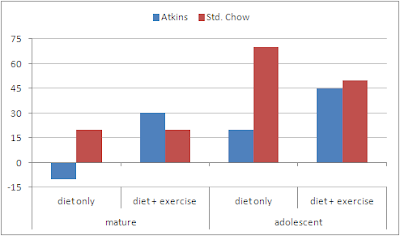 |
| Image 1: Your scale is a fat liar and putting too much trust in it is a potential hazard to your health. |
Extreme "Atkins diet" minimizes weight gain, but induces a "skinny fat" phenotype in exercised rodents
If you take a cursory look at the results you see exactly what the disciplines of Dr. Atkins will tell you: "It is so easy to lose weight and/or maintain your weight on this diet! You just cut your carbs and are good to go!"
 |
| Figure 1: Change in body weight in mature and adolescent rodents on "Atkins" or standard diet after the initial 10-day phase without exercise and at the end of the 21-day period with daily running exercise (to exhaustion, max. 30min; data adapted from Caton. 2012) |
 |
| Figure 2: Adipose tissue weight (mature animals, left) and volume (adolescent animals, right) at the end of the study period (data adapted from Caton. 2012) |
"Was that grass-fed butter and lard from pastured pigs?"
I can already hear them, the voices complaining how "unfair" this study was, how the Atkins group got "omega-6 laden fats" from "conventionally raised pigs" and butter that was not made from milk of "grass-fed cows". This, the low protein content of this extreme interpretation of the "Atkins diet" and the mere fact that we are dealing with a rodent, not a human study, are certainly all valid arguments (the latter two more than the former, though), but they don't change the basic message that no-carbing (without regular carb-loads) and working out hard don't go well together, at least not if your goal is to improve your health and physical appearance.
HIIT) exercise regimen to finally get in "decent shape", you better make good use of your improved insulin sensitivity and reintroduce a reasonable amount of carbs. Starting with 10g per meal, or 30g per day (not counting veggies) and building up to a level that allows you to keep losing body fat, while gaining or at least maintaining all the muscle mass you have, will also enable you to consume a decent amount of protein (get 20g of quality protein with every meal) without running into problems related to the sudden occurrence of large amounts of amino acid derived glucose in the veins of your "fat adapted" body. If, on the other hand, you are already in "at least decent" shape, fit and metabolically healthy, but still cannot lose those unaesthetic love handles. It may be time to start "playing" a little with your macros, in the way, but not just 1:1 like Adelfo has done it. A 5-6 day lower carb (carbohydrate intake placed around workouts; veggies don't count) strategy + 1weekly re-feed, where the reduction in carb intake gets you into a <20% caloric deficit will keep your insulin levels lowish and steady, will gradually reduce your glycogen stores, will ramp up AMPK and insulin sensitivity and will force your body to come up with the missing 20% of the energy from your adipose tissue, could be one way to success - a way, which unquestionably won't work for everyone and a way which will have to be tweaked to your own demands, but also a way which is not going to leave you lean on the outside and fat from within (cf. image 2).











0 comments:
Post a Comment